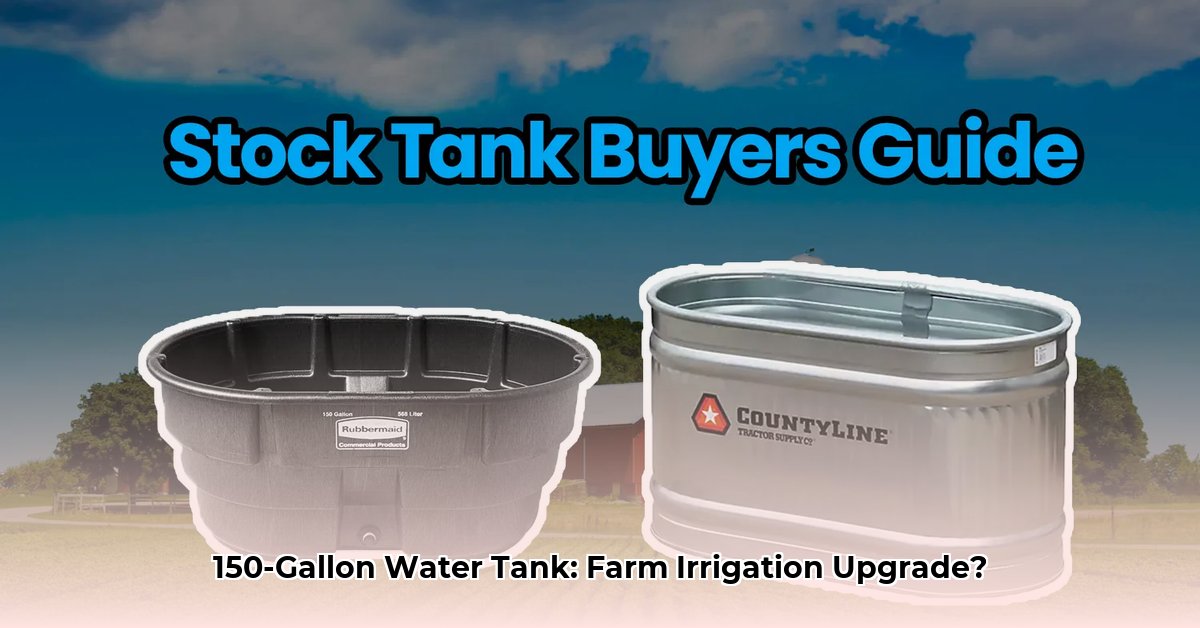
Running a successful farm often hinges on reliable water access. Unpredictable weather patterns and increasing water scarcity highlight the critical need for efficient water management strategies. A 150-gallon water tank, readily available at Tractor Supply and other retailers, offers a practical solution for boosting irrigation capabilities, but it's crucial to understand its limitations and consider alternatives for optimal farm water management. This guide helps you choose, install, maintain, and integrate a water storage system that best suits your specific farming needs. For more information on tractor supply water tanks, check out this helpful resource.
Choosing the Right Water Tank: Beyond Capacity
The first step isn’t simply purchasing a 150-gallon tank, but determining your actual water requirements. This depends on several factors: the type of crops you cultivate, the total acreage of your farm, and your irrigation method. Overwatering wastes a valuable resource while underwatering stresses crops, leading to reduced yields. Careful planning prevents both extremes.
Assessing Your Water Needs
How much water do your crops really need? This is a crucial first step. Consider factors like crop water use efficiency (CUE), which varies significantly between crops. For example, corn has a much higher water demand than drought-tolerant legumes. Accurate estimations can be obtained through local agricultural extension services or by using online calculators specific to your region and crops. Don't underestimate the importance of this step – it directly impacts the size and type of water storage solution you'll require.
Material Selection: A Cost-Benefit Analysis
The material of your water tank has profound implications for its lifespan, maintenance requirements, and environmental impact. Let's examine three common materials:
| Material | Pros | Cons |
|---|---|---|
| Plastic (Polyethylene) | Relatively inexpensive, lightweight, easy installation. | Susceptible to UV degradation, shorter lifespan, potential for leaching. |
| Steel | Durable, long-lasting. | More expensive initially, requires regular maintenance to prevent rust. |
| Concrete | Extremely durable, helps keep water cooler. | Most expensive, complex installation, requires a strong foundation. |
The 150-gallon plastic tank from Tractor Supply presents a balance of affordability and ease of use for smaller farms or gardens. However, for larger operations, its limited capacity and relatively short lifespan might prove costlier in the long run compared to higher-initial-cost options like steel or concrete. Consider the long-term total cost of ownership, including replacement costs.
Installation Considerations: Location and Infrastructure
Proper tank placement is crucial for efficient use and longevity. Select a level area with easy access for filling and cleaning. Avoid direct sunlight exposure, especially for plastic tanks, to minimize UV damage. Larger tanks may necessitate a sturdy concrete foundation to prevent settling. Proximity to a primary water source will minimize pumping needs and reduce energy costs.
Moreover, evaluate the need for additional infrastructure such as pumps, filters, and piping systems. This depends on the water source's location and the layout of your irrigation system. Always consult local regulations regarding building codes and obtaining necessary permits before installation.
Installing and Maintaining Your Water Tank: A Practical Guide
Correct installation ensures the tank's longevity and efficient operation. Follow these steps:
- Site Preparation: Level the chosen location, removing any debris or vegetation. Create a firm base for larger tanks, possibly a concrete slab or compacted gravel.
- Tank Placement (with appropriate lifting equipment): Carefully position the tank, ensuring it is level and stable. Secure it with straps or anchors if necessary, especially in windy areas.
- Plumbing Connections: Connect pipes or hoses securely, ensuring watertight seals. Use appropriate fittings and sealants to prevent leaks.
- Testing: Thoroughly inspect all connections and fill the tank slowly to check for leaks. Address any issues immediately.
Regular maintenance is paramount. Clean the tank periodically to prevent algae and bacterial growth. Regularly inspect for leaks, cracks, or any signs of damage. Protecting the tank from extreme weather conditions (sun exposure, freezing temperatures) prolongs its lifespan.
Integrating Your Tank into a Sustainable Water Management System
The 150-gallon tank should ideally be integrated into a broader water management strategy:
- Rainwater Harvesting: Collect rainwater from rooftops or other surfaces and divert it to your storage tank. This supplementary water source can significantly reduce reliance on municipal or well water.
- Efficient Irrigation Techniques: Use drip irrigation or other water-conserving methods to minimize water waste. This ensures every drop contributes to your crops' health and reduces overall water consumption.
Combining rainwater harvesting with efficient irrigation significantly enhances your water management strategy. Don't view the 150-gallon tank as a standalone solution but as a component within a more comprehensive water-wise system.
Other Water Storage Options: Expanding Your Capabilities
While the 150-gallon option is suitable for smaller operations, consider other solutions:
- Larger Capacity Tanks: For larger farms, larger tanks (500 gallons or more) provide greater water storage capacity.
- Above-ground vs. Underground Tanks: Above-ground tanks offer easier access but are more vulnerable to environmental factors. Underground tanks maintain more consistent water temperatures but are more complex to install.
The choice depends entirely on your farm's size, budget, and specific water needs. It's worth exploring all available options to find the best long-term solution for your particular requirements.
Conclusion: Investing in a Water-Secure Future
Investing in robust water storage is an investment in the long-term viability and resilience of your farm. By carefully considering your water requirements, choosing appropriate tank materials and size, executing proper installation and maintenance, and integrating your storage solution into a larger water management system, you can build a more sustainable and productive farm for years to come. Remember to prioritize responsible water use and explore all available options to find the solution best suited to your specific circumstances.